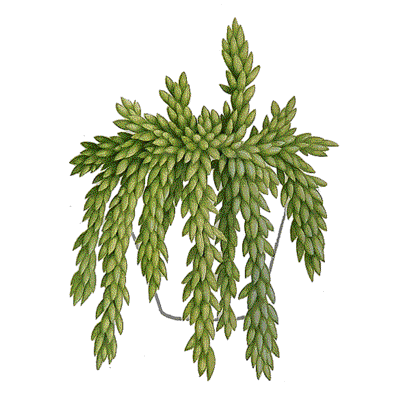

S. morganianum (burro's or donkey's tail)
CHARACTERISTICS: The burro's tail is a fascinating plant: its strange 1-inch-long tear-shaped leaves overlap so closely on pendant stems they seem to form 1- to 1 1/2-inch-thick braids as much as 1 1/2 feet long. The green succulent leaves are covered with a powdery blue dust, called bloom, like that found on blueberries and plums. The plants should be placed where they will be undisturbed because the leaves are attached flimsily and fall easily.
HOW TO GROW. Burro's tails do best
where they get four or more hours a day of direct sunlight, or where artificial
and natural light average 1,000 foot-candles over 12 hours a day, but they
will grow fairly well in bright indirect light, such as that reflected
from light walls. Night temperatures of 50° to 55° and day temperatures
of 68° to 72° are ideal. Let the soil become moderately dry between
thorough waterings from spring through fall; in winter, water only enough
to keep the leaves from shriveling. Feed established plants three times
a year, in very early spring, late spring and late summer; do not feed
them the rest of the year and wait four to six months before feeding newly
potted plants. Burro's tails rarely need repotting. Because the leaves
are brittle, feed and water old, overcrowded plants more often than usual
rather than repot them. If repotting is necessary, use a mixture consisting
of 1 part loam, 1 part leaf mold, 1 part sharp sand and 1/2 part crushed
charcoal, or else use a mixture of equal parts of a packaged general-purpose
potting soil and sharp sand; to each gallon pailful of whichever of these
mixtures you use, add 1 tablespoon of ground limestone and 1 tablespoon
of bone meal. Propagate at any season by inserting the bottom of an entire
leaf into sand. Watch for mealybugs.